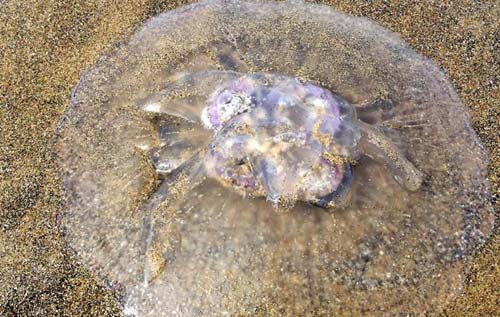A Bevy of Beach Finds on Oregon Coast Lately, Including Stinging Nettles
Published 07/22/2018 at 4:42 PM PDT - Updated 07/22/2018 at 6:22 PM PDT
By Oregon Coast Beach Connection Staff

(Oregon Coast) - A host of wacky wonders have been showing up all over the Oregon coast, largely thanks to a few days of west winds that drag a variety of lifeforms in. A few kinds of jellyfish, cellophane worm casings and freaky little bug-like creatures that look a tad like something out of Starship Troopers. (Photo above: a moon jelly, courtesy Haystack Awareness Program).
Includes exclusive listings; some specials in winter
In Cannon Beach:
Includes rentals not listed anywhere else
In Manzanita, Wheeler, Rockaway Beach:
Some specials for winter
In Pacific City, Oceanside:
Some specials for winter
In Lincoln City:
Some specials for winter
In Depoe Bay, Gleneden Beach:
Some specials for winter
In Newport:
Look for some specials
In Waldport
Some specials for winter
In Yachats, Florence
Some specials for winter
Tiffany Boothe of Seaside Aquarium as well as manager Keith Chandler said they’d seen moon jellies, sea nettles, cellophane worm casings and olive snails as of late. These reports are echoed by the volunteer group CoastWatch, where some members are reporting such creatures around the Florence area and even further south. Some reports were coming in to Oregon Coast Beach Connection about various forms of jellyfish at Lincoln City’s Road’s End area as well.
Cannon Beach’s Haystack Rock Awareness Program snagged a pic of a moon jelly in that area.
The one slightly unpleasant find are the various sea nettles that have washed up. These can sting, according to the Seaside Aquarium’s Chandler.
 “They can create a little welt like the plant called the nettle,” Chandler said. “They can even have the toxin in them when they’re dead.” (At right: piles of cellophane worm casings, courtesy Seaside Aquarium).
“They can create a little welt like the plant called the nettle,” Chandler said. “They can even have the toxin in them when they’re dead.” (At right: piles of cellophane worm casings, courtesy Seaside Aquarium).
The sea nettle is identifiable as a brownish jellyfish on the beach with long tentacles, as opposed to other harmless jellyfish which are clear and transparent. It’s the tentacles that can sting, Chandler said.
Aside from that creature, really everything else you’ll find on these beaches lately is harmless. Chandler advised simply not touching them.
Casings from cellophane worms (Spichaetopterus costarum) often wash ashore on the Oregon coast during the summer.
“Living just below the low tide line of sandy beaches, Cellophane Worms build and inhabit these seemingly plastic ‘tubes,’ which become encrusted with sand,” Boothe said. “Currents and upwellings bring these tubes to the surface, eventually distributing them onto shore.”
Then there’s the odd little critters hiding beneath the tideline as of late.
“People have been asking about these strange 'bumps' on the beach,” Boothe said. “There are usually only two culprits, either mole crabs or olive snails. To find out you must dig a little: this time it happened to be purple olive snails (Callianax biplicata). When the tide goes out these snails quickly burrow into the sand in order to stay wet and for added protection from predators.”
Boothe said hiding in the sand not only protects them predators but also from drying out in the sun. But strangely, the olive snail stays rather “pretty” this way, as Boothe phrased it.
“The sand polishes the snail's shell when the snail burrows into the sand, leaving the shell shiny,” Boothe said.
The only move at night, she said. Moreover, they’ve been sought after over the ages.
“The olive snail's glossy shell has been highly prized throughout human history,” Boothe said. “Illustrations made by early Spanish explorers show that coastal Natives made necklace strings of olive shells and used them to decorate their clothing.” Oregon Coast Lodgings for this - Where to eat - Maps - Virtual Tours ---- Photos of these creatures below:
Cannon Beach Lodging
Nehalem Bay Lodgings
Manzanita Hotels, Lodging
Three Capes Lodging
Pacific City Hotels, Lodging
Lincoln City Lodging
Depoe Bay Lodging
Newport Lodging
Waldport Lodging
Yachats Lodging
Oregon Coast Vacation Rentals
Oregon Coast Lodging Specials
Below: Olive snails and the bumps they hide under on the beach (courtesy Seaside Aquarium


Below: cellophane worm casings up close (courtesy Seaside Aquarium

Below: the stinging sea nettle in the water. Note the long tentacles (courtesy Seaside Aquarium)

More About Oregon Coast hotels, lodging.....
More About Oregon Coast Restaurants, Dining.....
LATEST Related Oregon Coast Articles
Dynamiting a bridge, almost blowing up a whale, crooner connection, more
Quadrantids Meteor Shower Peak Coming Up for Oregon, Washington, Coast Beaches
A very short peak just before dawn, Jan 3; a weird radio aspect. Astronomy, sciences
That Which Glows Above and Below Oregon Coast ? And Something New
Bioluminescence, aurora tales and some bizarre rarities captured. Weather
Sunday's Fall Equinox and the Bizarre to Sad Science of Sunset on Washington ...
Last sunset after 7 p.m. - sunset is a projection. Sciences
Oregon Coast Summer's Dreamy Discoveries May Include Weirdly Calm Waters
Summer is full of twists and turns, if you do it right. Depoe Bay
Near Depoe Bay, Fogarty Beach Has Some of the Oregon Coast's Strangest Shapes
The geology of Fogarty Beach is a wild one beneath
7 Bizarre Basalts of Oregon's North Coast: Lava Frozen in Time
It's an ancient, freaky story ? and a tad frightening. Oceanside, Yachats, Seaside, Newport, Cannon Beach, Newport
Oregon Coast / Washington Coast Answers: Those Strange, Snake-like Whips or T...
Bull kelp are a fun mystery on Northwest beaches. Marine sciences
Back to Oregon Coast
Contact Advertise on BeachConnection.net
All Content, unless otherwise attributed, copyright BeachConnection.net Unauthorized use or publication is not permitted














































